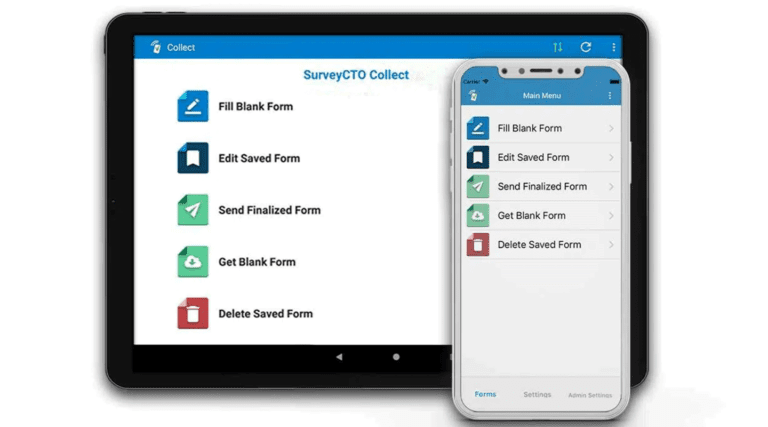A Guide to Data Collection: Methods, Process, and Tools

Whether your field is development economics, international development, the nonprofit sector, or myriad other industries, effective data collection is essential. It informs decision-making and increases your organization’s impact. However, the process of data collection can be complex and challenging.
If you’re in the beginning stages of creating a data collection process, this guide is for you. It outlines tested methods, efficient procedures, and effective tools to help you improve your data collection activities and outcomes.
At SurveyCTO, we’ve used our years of experience and expertise to build a robust, secure, and scalable mobile data collection platform. It’s trusted by respected institutions like The World Bank, J-PAL, Oxfam, and the Gates Foundation, and it’s changed the way many organizations collect and use data. With this guide, we want to share what we know and help you get ready to take the first step in your data collection journey.
Main takeaways from this guide
- Before starting the data collection process, define your goals and identify data sources, which can be primary (first-hand research) or secondary (existing resources).
- Your data collection method should align with your goals, resources, and the nature of the data needed. Surveys, interviews, observations, focus groups, and forms are common data collection methods.
- Sampling involves selecting a representative group from a larger population. Choosing the right sampling method to gather representative and relevant data is crucial.
- Crafting effective data collection instruments like surveys and questionnaires is key. Instruments should undergo rigorous testing for reliability and accuracy.
- Data collection is an ongoing, iterative process that demands real-time monitoring and adjustments to ensure high-quality, reliable results.
- After data collection, data should be cleaned to eliminate errors and organized for efficient analysis. The data collection journey further extends into data analysis, where patterns and useful information that can inform decision-making are discovered.
- Common challenges in data collection include data quality and consistency issues, data security concerns, and limitations with offline surveys. Employing robust data validation processes, implementing strong security protocols, and using offline-enabled data collection tools can help overcome these challenges.
- Data collection, entry, and management tools and data analysis, visualization, reporting, and workflow tools can streamline the data collection process, improve data quality, and facilitate data analysis.
What is data collection?

The traditional definition of data collection might lead us to think of gathering information through surveys, observations, or interviews. However, the modern-age definition of data collection extends beyond conducting surveys and observations. It encompasses the systematic gathering and recording of any kind of information through digital or manual methods. Data collection can be as routine as a doctor logging a patient’s information into an electronic medical record system during each clinic visit, or as specific as keeping a record of mosquito nets delivered to a rural household.
How to collect data: Getting started

Before starting your data collection process, you must clearly understand what you aim to achieve and how you’ll get there. Below are some actionable steps to help you get started.
1. Define your goals
Defining your goals is a crucial first step. Engage relevant stakeholders and team members in an iterative and collaborative process to establish clear goals. It’s important that projects start with the identification of key questions and desired outcomes to ensure you focus your efforts on gathering the right information.
Start by understanding the purpose of your project– what problem are you trying to solve, or what change do you want to bring about? Think about your project’s potential outcomes and obstacles and try to anticipate what kind of data would be useful in these scenarios. Consider who will be using the data you collect and what data would be the most valuable to them. Think about the long-term effects of your project and how you will measure these over time. Lastly, leverage any historical data from previous projects to help you refine key questions that may have been overlooked previously.
Once questions and outcomes are established, your data collection goals may still vary based on the context of your work. To demonstrate, let’s use the example of an international organization working on a healthcare project in a remote area.
- If you’re a researcher, your goal will revolve around collecting primary data to answer specific questions. This could involve designing a survey or conducting interviews to collect first-hand data on patient improvement, disease or illness prevalence, and behavior changes (such as an increase in patients seeking healthcare).
- If you’re part of the monitoring and evaluation (M&E) team, your goal will revolve around measuring the success of your healthcare project. This could involve collecting primary data through surveys or observations and developing a dashboard to display real-time metrics like the number of patients treated, percentage of reduction in incidences of disease,, and average patient wait times. Your focus would be using this data to implement any needed program changes and ensure your project meets its objectives.
- If you’re part of a field team, your goal will center around the efficient and accurate execution of project plans. You might be responsible for using data collection tools to capture pertinent information in different settings, such as in interviews takendirectly from the sample community or over the phone. The data you collect and manage will directly influence the operational efficiency of the project and assist in achieving the project’s overarching objectives.
2. Identify your data collection types
Essentially, there are two main data collection types to choose from: primary and secondary.
- Primary data is the information you collect directly from first-hand engagements. It’s gathered specifically for your research and tailored to your research question. Primary data collection methods can range from surveys and interviews to focus groups and observations. Because you design the data collection process, primary data can offer precise, context-specific information directly related to your research objectives. For example, suppose you are investigating the impact of a new education policy. In that case, primary data might be collected through surveys distributed to teachers or interviews with school administrators dealing directly with the policy’s implementation.
- Secondary data, on the other hand, is derived from resources that already exist. This can include information gathered for other research projects, administrative records, historical documents, statistical databases, and more. While not originally collected for your specific study, secondary data can offer valuable insights and background information that complement your primary data. For instance, continuing with the education policy example, secondary data might involve academic articles about similar policies, government reports on education or previous survey data about teachers’ opinions on educational reforms.
While both types of data have their strengths, this guide will predominantly focus on primary data and the methods to collect it. Primary data is often emphasized in research because it provides fresh, first-hand insights that directly address your research questions. Primary data also allows for more control over the data collection process, ensuring data is relevant, accurate, and up-to-date.
However, secondary data can offer critical context, allow for longitudinal analysis, save time and resources, and provide a comparative framework for interpreting your primary data. It can be a crucial backdrop against which your primary data can be understood and analyzed. While we focus on primary data collection methods in this guide, we encourage you not to overlook the value of incorporating secondary data into your research design where appropriate.
3. Choose your data collection methods
When choosing your data collection method, there are many options at your disposal. Data collection is not limited to methods like surveys and interviews. In fact, many of the processes in our daily lives serve the goal of collecting data, from intake forms to automated endpoints, such as payment terminals and mass transit card readers. Let us dive into some common types of data collection methods:
Surveys and Questionnaires
Surveys and questionnaires are tools for gathering information about a group of individuals, typically by asking them predefined questions. They can be used to collect quantitative and qualitative data and be administered in various ways, including online, over the phone, in person (offline), or by mail.
- Advantages: Surveys allows researchers to reach many participants quickly and cost-effectively, making them ideal for large-scale studies. The structured format of survey questions can also make analysis easier than other methods.
- Disadvantages: Survey data collection may not capture complex or nuanced information well, as participants are limited to predefined response choices. Also, there can be issues with response bias, where participants might provide socially desirable answers rather than honest ones.
Interviews
Interviews involve a one-on-one conversation between the researcher and the participant. The interviewer asks open-ended questions to gain detailed information about the participant’s thoughts, feelings, experiences, and behaviors.
- Advantages: They allow for an in-depth understanding of the topic at hand. The researcher can adapt the questioning in real time based on the participant’s responses, allowing for more flexibility.
- Disadvantages: They can be time-consuming and resource-intensive, as they require trained interviewers and a significant amount of time for both conducting and analyzing responses. They may also introduce interviewer bias if not conducted carefully, due to how an interviewer presents questions and perceives the respondent, and how the respondent perceives the interviewer.
Observations
Observations involve directly observing and recording behavior or other phenomena as they occur in their natural settings.
- Advantages: Observations can provide valuable contextual information, as researchers can study behavior in the environment where it naturally occurs, reducing the risk of artificiality associated with laboratory settings or self-reported measures.
- Disadvantages: Observational studies may suffer from observer bias, where the observer’s expectations or biases could influence their interpretation of the data. Also, some behaviors might be altered if subjects are aware they are being observed.
Focus Groups
Focus groups are guided discussions among selected individuals to gain information about their views and experiences.
- Advantages: Focus groups allow for interaction among participants, which can generate a diverse range of opinions and ideas. They are good for exploring new topics where there is little pre-existing knowledge.
- Disadvantages: Dominant voices in the group can sway the discussion, potentially silencing less assertive participants. They also require skilled facilitators to moderate the discussion effectively.
Forms
Forms are standardized documents with blank fields for collecting data in a systematic manner. They are often used in fields like Customer Relationship Management (CRM) or Electronic Medical Records (EMR) data entry. Surveys may also be referred to as forms.
- Advantages: Forms are versatile, easy to use, and efficient for data collection. They can streamline workflows by standardizing the data entry process.
- Disadvantages: They may not provide in-depth insights as the responses are typically structured and limited. There is also potential for errors in data entry, especially when done manually.
Selecting the right data collection method should be an intentional process, taking into consideration the unique requirements of your project. The method selected should align with your goals, available resources, and the nature of the data you need to collect.
If you aim to collect quantitative data, surveys, questionnaires, and forms can be excellent tools, particularly for large-scale studies. These methods are suited to providing structured responses that can be analyzed statistically, delivering solid numerical data.
However, if you’re looking to uncover a deeper understanding of a subject, qualitative data might be more suitable. In such cases, interviews, observations, and focus groups can provide richer, more nuanced insights. These methods allow you to explore experiences, opinions, and behaviors deeply. Some surveys can also include open-ended questions that provide qualitative data.
The cost of data collection is also an important consideration. If you have budget constraints, in-depth, in-person conversations with every member of your target population may not be practical. In such cases, distributing questionnaires or forms can be a cost-saving approach.
Additional considerations include language barriers and connectivity issues. If your respondents speak different languages, consider translation services or multilingual data collection tools. If your target population resides in areas with limited connectivity and your method will be to collect data using mobile devices, ensure your tool provides offline data collection, which will allow you to carry out your data collection plan without internet connectivity.
4. Determine your sampling method
Now that you’ve established your data collection goals and how you’ll collect your data, the next step is deciding whom to collect your data from. Sampling involves carefully selecting a representative group from a larger population. Choosing the right sampling method is crucial for gathering representative and relevant data that aligns with your data collection goal.
Consider the following guidelines to choose the appropriate sampling method for your research goal and data collection method:
- Understand Your Target Population: Start by conducting thorough research of your target population. Understand who they are, their characteristics, and subgroups within the population.
- Anticipate and Minimize Biases: Anticipate and address potential biases within the target population to help minimize their impact on the data. For example, will your sampling method accurately reflect all ages, gender, cultures, etc., of your target population? Are there barriers to participation for any subgroups? Your sampling method should allow you to capture the most accurate representation of your target population.
- Maintain Cost-Effective Practices: Consider the cost implications of your chosen sampling methods. Some sampling methods will require more resources, time, and effort. Your chosen sampling method should balance the cost factors with the ability to collect your data effectively and accurately.
- Consider Your Project’s Objectives: Tailor the sampling method to meet your specific objectives and constraints, such as M&E teams requiring real-time impact data and researchers needing representative samples for statistical analysis.
By adhering to these guidelines, you can make informed choices when selecting a sampling method, maximizing the quality and relevance of your data collection efforts.
5. Identify and train data collectors
Not every data collection use case requires data collectors, but training individuals responsible for data collection becomes crucial in scenarios involving field presence.
The SurveyCTO platform supports both self-response survey modes and surveys that require a human field worker to do in-person interviews. Whether you’re hiring and training data collectors, utilizing an existing team, or training existing field staff, we offer comprehensive guidance and the right tools to ensure effective data collection practices.
Here are some common training approaches for data collectors:
- In-Class Training: Comprehensive sessions covering protocols, survey instruments, and best practices empower data collectors with skills and knowledge.
- Tests and Assessments: Assessments evaluate collectors’ understanding and competence, highlighting areas where additional support is needed.
- Mock Interviews: Simulated interviews refine collectors’ techniques and communication skills.
- Pre-Recorded Training Sessions: Accessible reinforcement and self-paced learning to refresh and stay updated.
Training data collectors is vital for successful data collection techniques. Your training should focus on proper instrument usage and effective interaction with respondents, including communication skills, cultural literacy, and ethical considerations.
Remember, training is an ongoing process. Knowledge gaps and issues may arise in the field, necessitating further training.
Moving Ahead: Iterative Steps in Data Collection

Once you’ve established the preliminary elements of your data collection process, you’re ready to start your data collection journey. In this section, we’ll delve into the specifics of designing and testing your instruments, collecting data, and organizing data while embracing the iterative nature of the data collection process, which requires diligent monitoring and making adjustments when needed.
6. Design and test your instruments
Designing effective data collection instruments like surveys and questionnaires is key. It’s crucial to prioritize respondent consent and privacy to ensure the integrity of your research. Thoughtful design and careful testing of survey questions are essential for optimizing research insights. Other critical considerations are:
- Clear and Unbiased Question Wording: Craft unambiguous, neutral questions free from bias to gather accurate and meaningful data. For example, instead of asking, “Shouldn’t we invest more into renewable energy that will combat the effects of climate change?” ask your question in a neutral way that allows the respondent to voice their thoughts. For example: “What are your thoughts on investing more in renewable energy?”
- Logical Ordering and Appropriate Response Format: Arrange questions logically and choose response formats (such as multiple-choice, Likert scale, or open-ended) that suit the nature of the data you aim to collect.
- Coverage of Relevant Topics: Ensure that your instrument covers all topics pertinent to your data collection goals while respecting cultural and social sensitivities. Make sure your instrument avoids assumptions, stereotypes, and languages or topics that could be considered offensive or taboo in certain contexts. The goal is to avoid marginalizing or offending respondents based on their social or cultural background.
- Collect Only Necessary Data: Design survey instruments that focus solely on gathering the data required for your research objectives, avoiding unnecessary information.
- Language(s) of the Respondent Population: Tailor your instruments to accommodate the languages your target respondents speak, offering translated versions if needed. Similarly, take into account accessibility for respondents who can’t read by offering alternative formats like images in place of text.
- Desired Length of Time for Completion: Respect respondents’ time by designing instruments that can be completed within a reasonable timeframe, balancing thoroughness with engagement. Having a general timeframe for the amount of time needed to complete a response will also help you weed out bad responses. For example, a response that was rushed and completed outside of your response timeframe could indicate a response that needs to be excluded.
- Collecting and Documenting Respondents’ Consent and Privacy: Ensure a robust consent process, transparent data usage communication, and privacy protection throughout data collection.
Perform Cognitive Interviewing
Cognitive interviewing is a method used to refine survey instruments and improve the accuracy of survey responses by evaluating how respondents understand, process, and respond to the instrument’s questions. In practice, cognitive interviewing involves an interview with the respondent, asking them to verbalize their thoughts as they interact with the instrument. By actively probing and observing their responses, you can identify and address ambiguities, ensuring accurate data collection.
Thoughtful question wording, well-organized response options, and logical sequencing enhance comprehension, minimize biases, and ensure accurate data collection. Iterative testing and refinement based on respondent feedback improve the validity, reliability, and actionability of insights obtained.
Put Your Instrument to the Test
Through rigorous testing, you can uncover flaws, ensure reliability, maximize accuracy, and validate your instrument’s performance. This can be achieved by:
- Conducting pilot testing to enhance the reliability and effectiveness of data collection. Administer the instrument, identify difficulties, gather feedback, and assess performance in real-world conditions.
- Making revisions based on pilot testing to enhance clarity, accuracy, usability, and participant satisfaction. Refine questions, instructions, and format for effective data collection.
- Continuously iterating and refining your instrument based on feedback and real-world testing. This ensures reliable, accurate, and audience-aligned methods of data collection. Additionally, this ensures your instrument adapts to changes, incorporates insights, and maintains ongoing effectiveness.
7. Collect your data
Now that you have your well-designed survey, interview questions, observation plan, or form, it’s time to implement it and gather the needed data. Data collection is not a one-and-done deal; it’s an ongoing process that demands attention to detail. Imagine spending weeks collecting data, only to discover later that a significant portion is unusable due to incomplete responses, improper collection methods, or falsified responses. To avoid such setbacks, adopt an iterative approach.
Leverage data collection tools with real-time monitoring to proactively identify outliers and issues. Take immediate action by fine-tuning your instruments, optimizing the data collection process, addressing concerns like additional training, or reevaluating personnel responsible for inaccurate data (for example, a field worker who sits in a coffee shop entering fake responses rather than doing the work of knocking on doors).
SurveyCTO’s Data Explorer was specifically designed to fulfill this requirement, empowering you to monitor incoming data, gain valuable insights, and know where changes may be needed. Embracing this iterative approach ensures ongoing improvement in data collection, resulting in more reliable and precise results.
8. Clean and organize your data
After data collection, the next step is to clean and organize the data to ensure its integrity and usability.
- Data Cleaning: This stage involves sifting through your data to identify and rectify any errors, inconsistencies, or missing values. It’s essential to maintain the accuracy of your data and ensure that it’s reliable for further analysis. Data cleaning can uncover duplicates, outliers, and gaps that could skew your results if left unchecked. With real-time data monitoring, this continuous cleaning process keeps your data precise and current throughout the data collection period. Similarly, review and corrections workflows allow you to monitor the quality of your incoming data.
- Organizing Your Data: Post-cleaning, it’s time to organize your data for efficient analysis and interpretation. Labeling your data using appropriate codes or categorizations can simplify navigation and streamline the extraction of insights. When you use a survey or form, labeling your data is often not necessary because you can design the instrument to collect in the right categories or return the right codes. An organized dataset is easier to manage, analyze, and interpret, ensuring that your collection efforts are not wasted but lead to valuable, actionable insights.
Remember, each stage of the data collection process, from design to cleaning, is iterative and interconnected. By diligently cleaning and organizing your data, you are setting the stage for robust, meaningful analysis that can inform your data-driven decisions and actions.
What happens after data collection?

The data collection journey takes us next into data analysis, where you’ll uncover patterns, empowering informed decision-making for researchers, evaluation teams, and field personnel.
Process and Analyze Your Data
Explore data through statistical and qualitative techniques to discover patterns, correlations, and insights during this pivotal stage. It’s about extracting the essence of your data and translating numbers into knowledge. Whether applying descriptive statistics, conducting regression analysis, or using thematic coding for qualitative data, this process drives decision-making and charts the path toward actionable outcomes.
Interpret and Report Your Results
Interpreting and reporting your data brings meaning and context to the numbers. Translating raw data into digestible insights for informed decision-making and effective stakeholder communication is critical.
The approach to interpretation and reporting varies depending on the perspective and role:
- Researchers often lean heavily on statistical methods to identify trends, extract meaningful conclusions, and share their findings in academic circles, contributing to their knowledge pool.
- M&E teams typically produce comprehensive reports, shedding light on the effectiveness and impact of programs. These reports guide internal and sometimes external stakeholders, supporting informed decisions and driving program improvements.
Field teams provide a first-hand perspective. Since they are often the first to see the results of the practical implementation of data, field teams are instrumental in providing immediate feedback loops on project initiatives. Field teams do the work that provides context to help research and M&E teams understand external factors like the local environment, cultural nuances, and logistical challenges that impact data results.
Safely store and handle data
Throughout the data collection process, and after it has been collected, it is vital to follow best practices for storing and handling data to ensure the integrity of your research. While the specifics of how to best store and handle data will depend on your project, here are some important guidelines to keep in mind:
- Use cloud storage to hold your data if possible, since this is safer than storing data on hard drives and keeps it more accessible,
- Periodically back up and purge old data from your system, since it’s safer to not retain data longer than necessary,
- If you use mobile devices to collect and store data, use options for private, internal apps-specific storage if and when possible,
- Restrict access to stored data to only those who need to work with that data.
Further considerations for data safety are discussed below in the section on data security.
Remember to uphold ethical standards in interpreting and reporting your data, regardless of your role. Clear communication, respectful handling of sensitive information, and adhering to confidentiality and privacy rights are all essential to fostering trust, promoting transparency, and bolstering your work’s credibility.
Common Data Collection Challenges

Data collection is vital to data-driven initiatives, but it comes with challenges. Addressing common challenges such as poor data quality, privacy concerns, inadequate sample sizes, and bias is essential to ensure the collected data is reliable, trustworthy, and secure.
In this section, we’ll explore three major challenges: data quality and consistency issues, data security concerns, and limitations with offline data collection, along with strategies to overcome them.
Data Quality and Consistency
Data quality and consistency refer to data accuracy and reliability throughout the collection and analysis process.
Challenges such as incomplete or missing data, data entry errors, measurement errors, and data coding/categorization errors can impact the integrity and usefulness of the data.
To navigate these complexities and maintain high standards, consistency, and integrity in the dataset:
- Implement robust data validation processes,
- Ensure proper training for data entry personnel,
- Employ automated data validation techniques, and
- Conduct regular data quality audits.
Data security
Data security encompasses safeguarding data through ensuring data privacy and confidentiality, securing storage and backup, and controlling data sharing and access.
Challenges include the risk of potential breaches, unauthorized access, and the need to comply with data protection regulations.
To address these setbacks and maintain privacy, trust, and confidence during the data collection process:
- Use encryption and authentication methods,
- Implement robust security protocols,
- Update security measures regularly,
- Provide employee training on data security, and
- Adopt secure cloud storage solutions.
Offline Data Collection
Offline data collection refers to the process of gathering data using modes like mobile device-based computer-assisted personal interviewing (CAPI) when there is an inconsistent or unreliable internet connection, and the data collection tool being used for CAPI has the functionality to work offline.
Challenges associated with offline data collection include synchronization issues, difficulty transferring data, and compatibility problems between devices, and data collection tools.
To overcome these challenges and enable efficient and reliable offline data collection processes, employ the following strategies:
- Leverage offline-enabled data collection apps or tools that enable you to survey respondents even when there’s no internet connection, and upload data to a central repository at a later time.
- Your data collection plan should include times for periodic data synchronization when connectivity is available,
- Use offline, device-based storage for seamless data transfer and compatibility, and
- Provide clear instructions to field personnel on handling offline data collection scenarios.
Utilizing Technology to Collect Data

Embracing technology throughout your data collection process can help you overcome many challenges described in the previous section. Data collection tools can streamline your data collection, improve the quality and security of your data, and facilitate the analysis of your data. Let’s look at two broad categories of tools that are essential for data collection:
Data Collection Tools for Entry, Management, and More
These data collection tools help with data gathering, input, and organization. They can range from digital survey data collection tools to comprehensive database systems, allowing you to gather, enter, and manage your data effectively. They can significantly simplify the data collection process, minimize human error, and offer practical ways to organize and manage large volumes of data. Some of these tools are:
- Microsoft Office
- Google Docs
- MySQL
- PostgreSQL
- SurveyMonkey
- Google Forms
- Qualtrics
- SurveyCTO
Data Analysis, Visualization, Reporting, & Workflow Tools
These tools assist in processing and interpreting the collected data. They provide a way to visualize data in a user-friendly format, making it easier to identify trends and patterns. These tools can also generate comprehensive reports to share your findings with stakeholders and help manage your workflow efficiently. By automating complex tasks, they can help ensure accuracy and save time. Tools for these purposes include:
- Google sheets
- Stata
- Power BI
- SPSS
Data collection tools like SurveyCTO often have integrations to help users seamlessly transition from data collection to data analysis, visualization, reporting, and managing workflows.
Master Your Data Collection Process With SurveyCTO
As we bring this guide to a close, you now possess a wealth of knowledge to develop your data collection process. From understanding the significance of setting clear goals to the crucial process of selecting your data collection methods and addressing common challenges, you are equipped to handle the intricate details of this dynamic process.
Remember, you’re not venturing into this complex process alone. At SurveyCTO, we offer not just a tool but an entire support system committed to your success. Beyond troubleshooting support, our success team serves as research advisors and expert partners, ready to provide guidance at every stage of your data collection journey.
With SurveyCTO, you can design flexible surveys in Microsoft Excel or Google Sheets, collect data online and offline with above-industry-standard security, monitor your data in real time, use the Data Explorer to visualize incoming data at both individual survey and aggregate levels instantly, and export it for further analysis in any tool of your choice. We also make getting started easy, with customizable templates to help you structure and format your data collection.
In the iterative data collection process, our users tell us that SurveyCTO stands out with its capacity to establish review and correction workflows. It enables you to monitor incoming data and configure automated quality checks to flag error-prone submissions.
Finally, data security is of paramount importance to us. We ensure best-in-class security measures like SOC 2 compliance, end-to-end encryption, single sign-on (SSO), GDPR-compliant setups, customizable user roles, and self-hosting options to keep your data safe.
As you embark on your data collection journey, you can count on SurveyCTO’s experience and expertise to be by your side every step of the way. Our team would be excited and honored to be a part of your research project, offering you the tools and processes to gain informative insights and make effective decisions. Partner with us today and revolutionize the way you collect data.
Better data, better decision making, better world.



